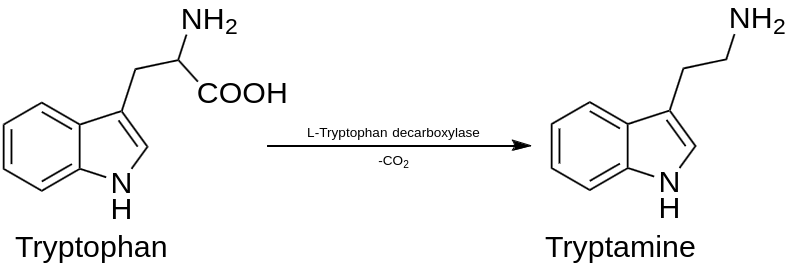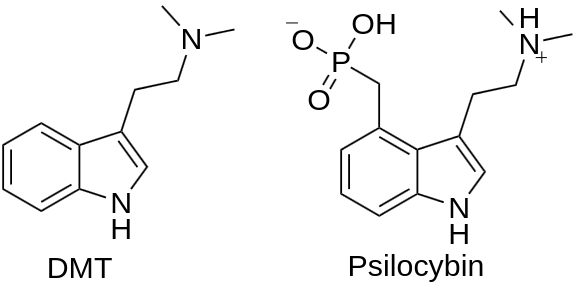- The process of creating a drug - May 23, 2023
- How do scientists model mental disorders in animals? - May 23, 2023
Introduction to Tryptamine Chemistry
Tryptamine is an organic compound that serves as the backbone for a wide array of biologically active molecules. Found in nature and in various forms, from neurotransmitters like serotonin to psychedelics like psilocybin, tryptamine has been a subject of extensive study and debate. Its presence in multiple biological pathways makes it a molecule of significant interest in both chemistry and biology. This article aims to provide an overview of tryptamine’s chemistry, including its physical and chemical properties, synthetic routes, biological significance, applications, and safety concerns.

Tryptamine Physical and Chemical Properties
Tryptamine, an indole alkaloid, possesses a structure characterized by a bicyclic indole ring system attached to an ethylamine chain. Let’s delve deeper into its physical and chemical attributes:
Molecular Structure:
Tryptamine’s basic structure consists of a planar indole nucleus, which is essentially a benzene ring fused to a pyrrole ring, and an ethylamine side chain projecting from the nitrogen of the pyrrole. This structure forms the foundation for many naturally occurring and synthetic compounds.

Physical Properties:
- State and Appearance: Typically, tryptamine appears as a white to slightly yellow crystalline solid.
- Melting Point: The melting point of tryptamine ranges between 113–116 °C.
- Boiling Point: It has a boiling point of approximately 378 °C.
- Solubility: While it demonstrates good solubility in organic solvents like ethanol and chloroform, it exhibits limited solubility in water.
Chemical Reactivity:
The indole ring in tryptamine can undergo electrophilic and nucleophilic substitution reactions, especially at the 3-position due to electron density concentration. The ethylamine side chain also offers a site for reactions, including alkylation and acylation.
pKa Value:
Tryptamine has a pKa value close to 10.6 for its conjugate acid, suggesting that at physiological pH, a significant fraction exists in its protonated form.
Stability:
Tryptamine is sensitive to oxidation, especially in the presence of air and light. When oxidized, it can form various products, including indigo dye derivatives.
Chemical Behavior:
Its behavior is influenced majorly by the interplay between the electron-rich indole ring and the amine functional group. This balance drives its reactions, binding with receptors in biological systems, and its role as a precursor to more complex molecules.
Synthetic Routes to Tryptamine
Tryptamine, with its intriguing molecular structure, has piqued the interest of organic chemists for decades. Over time, various synthesis methods have been developed to generate tryptamine both efficiently and effectively. Here are some detailed routes for the synthesis of tryptamine:
1. Decarboxylation of Tryptophan
One of the most traditional routes involves starting with the amino acid tryptophan.
Method: Tryptophan undergoes decarboxylation, typically facilitated by heat or specific catalysts, to produce tryptamine.
Advantages: This method is straightforward and utilizes a readily available starting material.
Drawbacks: The process can be somewhat inefficient and may require high temperatures.

2. 3-(2-Nitrovinyl)indole Reduction Method
3-(2-Nitrovinyl)indole is sparingly soluble in ether, however by using so-called Soxhlet extraction technique, it could be reduced to tryptamine.

15 g of 3-(2-nitrovinyl)indole is extracted during 8 hours from a Soxhlet thimble into a flask containing 15 g of lithium aluminum hydride dissolved in 300 ml anhydrous ether. The mixture is then treated with 80 ml water, slowly and with cooling, and filtered. The ether solution is separated, dried over sodium sulfate, and saturated with hydrogen chloride. 12.7 g of tryptamine hydrochloride is obtained. After crystallization from methanol-ethyl acetate tryptamine hydrochloride melts at 249-250° C.
3. Enzymatic Route
With the growing interest in green chemistry, enzymatic synthesis has emerged as an attractive option.
Method: Enzymes like tryptophan decarboxylase can be utilized to convert tryptophan to tryptamine in biocatalytic processes.
Advantages: These routes can be more environmentally friendly and can often be run under mild conditions.
Drawbacks: Enzymatic methods might be slower, and finding or producing the right enzyme can be a challenge.
As research continues, more efficient, cost-effective, and environmentally friendly methods for tryptamine synthesis will likely be developed. The selection of a particular method often depends on the desired yield, purity, and specific requirements of a research or industrial project.
Biological Significance of Tryptamine
Tryptamine, while seemingly simple in structure, plays a profound role in the realm of biology, forming the core structure of a myriad of physiologically relevant compounds.
Neurotransmitters and Neuromodulators:
At the forefront, tryptamine serves as a precursor to serotonin, a key neurotransmitter that regulates mood, appetite, and sleep among other physiological processes. Similarly, melatonin, which is pivotal in regulating circadian rhythms and sleep cycles, also has its roots in tryptamine biochemistry.
Endogenous Presence:
While trace amounts of tryptamine are found naturally in the human brain, its exact role is still a subject of research. In certain invertebrate species, tryptamine acts directly as a neurotransmitter.
Psychoactive Derivatives:
Beyond its role as a precursor, the tryptamine skeleton is also fundamental to several psychoactive compounds. Compounds like DMT (Dimethyltryptamine) and psilocybin, found in various plants and fungi, have profound effects on human consciousness and have been subjects of both traditional use in indigenous cultures and modern scientific research.

Enzymatic Pathways:
Tryptamine’s biological transformations are orchestrated by a series of enzymes. For instance, the conversion of tryptamine to serotonin involves the enzyme aromatic L-amino acid decarboxylase. These enzymatic pathways underscore tryptamine’s embedded role in complex biochemical networks.
The intricate dance of tryptamine within biological systems emphasizes its significance not only as a standalone entity but also as a foundational component in a broad spectrum of bioactive molecules. This makes it a molecule of compelling interest for researchers across disciplines, from biochemistry to pharmacology and neuroscience.
Tryptamine Applications
The versatile structure and biological relevance of tryptamine have opened the doors to a plethora of applications, both in the realms of research and medicine.
1. Pharmaceutical Research:
One of the primary domains where tryptamine has proven indispensable is in the pharmaceutical sector.
Antidepressants: Tryptamine’s close relationship with serotonin, a mood-regulating neurotransmitter, makes it a focal point in the synthesis of certain antidepressant drugs.
Migraine Medications: Certain tryptamine derivatives have been explored for their potential in treating migraines due to their vascular effects.
Antihypertensive Agents: Some tryptamine derivatives have demonstrated properties that make them viable candidates as antihypertensive drugs.
2. Neurological Research:
Given its presence and the plethora of derivatives in the nervous system, tryptamine forms a cornerstone in neurological studies.
Psychedelic Studies: Compounds like DMT, rooted in the tryptamine structure, are currently undergoing research for their potential therapeutic applications, especially concerning mental health disorders such as depression, anxiety, and PTSD.
Neurotransmission Studies: Understanding tryptamine’s role and its interaction with various neurotransmitter systems offers insights into the intricate workings of the brain.
3. Chemical Precursor:
Tryptamine’s modifiable structure makes it an ideal starting point for the synthesis of a wide array of organic compounds, both naturally occurring and synthetic. Its malleability in chemical reactions has enabled the creation of diverse molecules for various research pursuits.
4. Traditional and Ethnobotanical Uses:
Tryptamine and its derivatives, present in several plants and fungi, have been integral to various indigenous practices, rituals, and traditional medicines. Understanding these uses can provide unique insights into the human psyche and the cultural significance of these compounds.
5. Biochemical Assays:
In the realm of biochemistry, tryptamine can serve as a substrate in various enzymatic assays, helping in the understanding and characterization of enzymes like tryptophan hydroxylase or decarboxylases.
The myriad applications of tryptamine, spanning from clinical uses to profound psycho-spiritual experiences, underscore its multifaceted importance in science, medicine, and culture. As research continues, it’s likely that new and exciting applications will emerge, further cementing tryptamine’s significance in various fields.

Tryptamine Handling, Safety, and Regulations
Given its biological activity, the handling of tryptamine and its derivatives is subject to strict regulations. Safety measures include the use of personal protective equipment and fume hoods when handling the compound in a lab setting. Additionally, the storage, usage, and disposal of tryptamine are regulated by various agencies, including the FDA in the United States. Misuse of tryptamine or its derivatives could result in legal repercussions.
Conclusion
Tryptamine stands at a unique crossroad of chemistry and biology, captivating scientists with its complex structure and biological significance. As the foundation for numerous physiologically active compounds, its relevance in organic chemistry, medicine, and neuroscience cannot be overstated. Future research promises to further unravel its potential applications and deepen our knowledge of its intricate roles in various systems.
Bibliography
E. H. P. Young, J. Chem. Soc, 1958, 3493
Jones, R. S. G. “Tryptamine: a neuromodulator or neurotransmitter in mammalian brain?.” Progress in neurobiology 19.1-2 (1982): 117-139. https://www.sciencedirect.com/science/article/pii/0301008282900235
Araújo, Ana Margarida, et al. “The hallucinogenic world of tryptamines: an updated review.” Archives of toxicology 89 (2015): 1151-1173. https://link.springer.com/article/10.1007/s00204-015-1513-x
Gaddum, J. H., and ZP1509685 Picarelli. “Two kinds of tryptamine receptor.” British journal of pharmacology and chemotherapy 12.3 (1957): 323-328. https://bpspubs.onlinelibrary.wiley.com/doi/abs/10.1111/j.1476-5381.1957.tb00142.x

